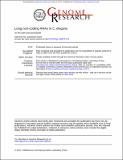Long non-coding RNAs in C. elegans
Author(s)
Nam, Jin-Wu; Bartel, David
DownloadBartel_Long non-coding.pdf (3.769Mb)
OPEN_ACCESS_POLICY
Open Access Policy
Creative Commons Attribution-Noncommercial-Share Alike
Terms of use
Metadata
Show full item recordAbstract
Thousands of long non-coding RNAs (lncRNAs) have been found in vertebrate animals, a few of which have known biological roles. To better understand the genomics and features of lncRNAs in invertebrates, we used available RNA-seq, poly(A)-site, and ribosome-mapping data to identify lncRNAs of C. elegans. We found 170 long intervening ncRNAs (lincRNAs), which had single- or multi-exonic structures that did not overlap protein-coding transcripts, and about sixty antisense lncRNAs (ancRNAs), which were complementary to protein-coding transcripts. Compared to protein-coding genes, the lncRNA genes tended to be expressed in stage-dependent manner. Approximately 25% of the newly identified lincRNAs showed little signal for sequence conservation and mapped antisense to clusters of endogenous siRNAs, as would be expected if they serve as templates and targets for these siRNAs. The other 75% tended to be more conserved and included lincRNAs with intriguing expression and sequence features associating them with processes such as dauer formation, male identity, sperm formation, and interaction with sperm-specific mRNAs. Our study provides a glimpse into the lncRNA content of a non-vertebrate animal and a resource for future studies of lncRNA function.
Date issued
2012-06Department
Massachusetts Institute of Technology. Department of BiologyJournal
Genome Research
Publisher
Cold Spring Harbor Laboratory Press
Citation
Nam, J.-W., and D. Bartel. “Long Non-coding RNAs in C. Elegans.” Genome Research (2012).
Version: Author's final manuscript
ISSN
1088-9051
1088-9051